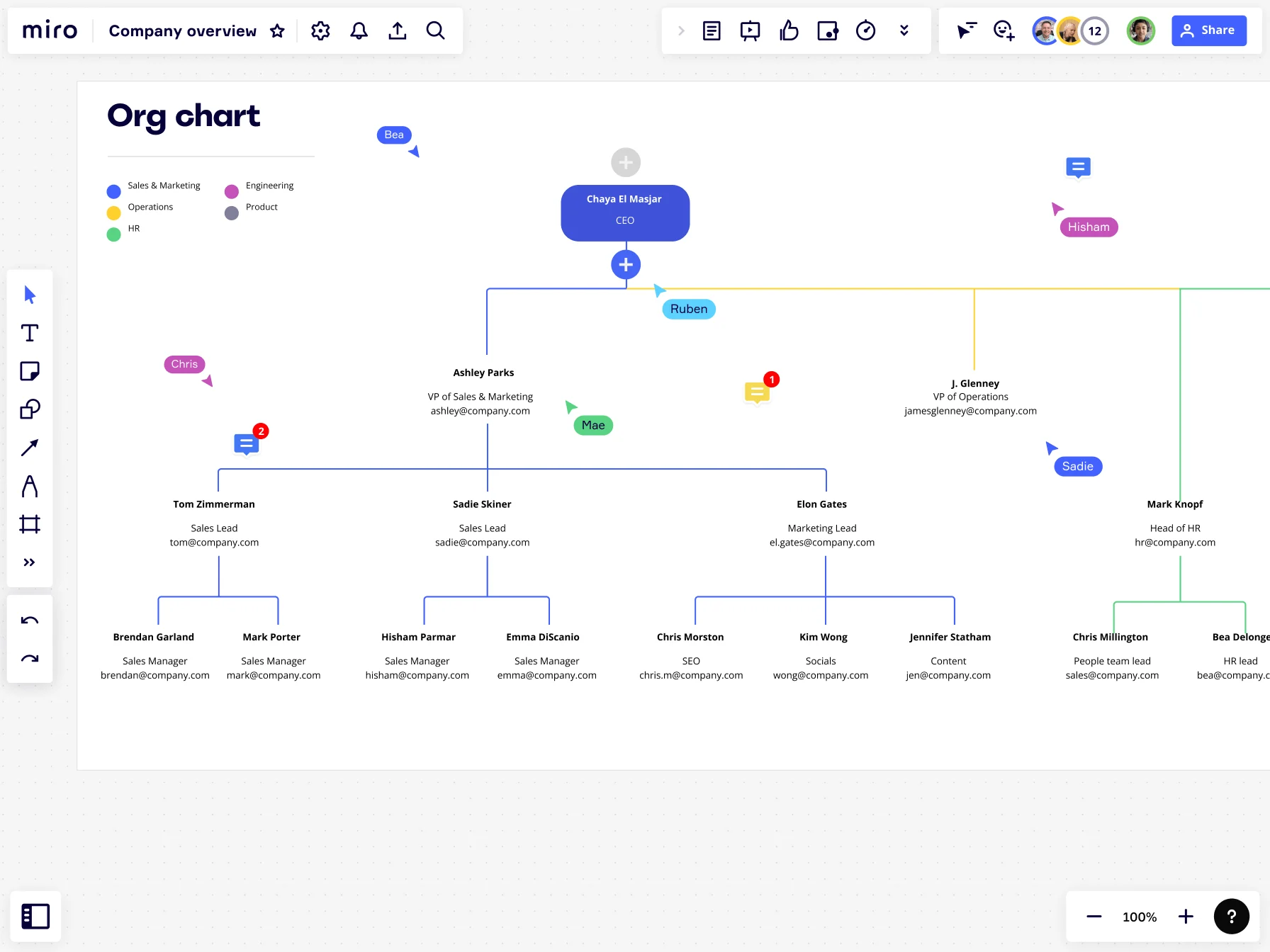
Table of contents
Table of contents
Organizational chart for a small business

Summary
In this guide, you will learn:
- How to create org charts for small businesses using Miro’s templates.
- The importance of defining company structure and collecting employee info for accurate org charts.
- How Miro’s org chart maker improves team alignment, communication, and planning with real-time collaboration.
- Steps to build, share, and maintain up-to-date org charts as living documents.
- Different org chart types, and how to personalize them with colors, photos, and connectors.
- Best practices for integrating org charts with other tools for onboarding, project planning, and resource allocation.
Try Miro now
Join thousands of teams using Miro to do their best work yet.
What is a business organizational chart?
Whether you're a seasoned business owner or a novice entrepreneur, there's one powerful tool you should always have in your management toolbox - the business organizational chart - a visual representation of the hierarchical structure of an organization. It shows the relationships and relative ranks of the company's parts and positions/jobs. Much like a family tree, it details who reports to whom, the levels of management, and the lines of communication and authority.
In a small business, where roles might be multifunctional, and employees may wear several hats, an organizational chart can help create clarity, foster an understanding of responsibilities, and facilitate smoother operations. This article will help you understand the purpose and structure of a business organizational chart, how to create one, and the benefits it can bring to your small business.
Understanding how a business organizational chart Works for small organizations
While large corporations often have complex, multi-tiered organizational charts, small businesses typically employ more superficial, flexible structures. The business size doesn't negate the need for an organizational chart. Having one in a small business may be even more beneficial due to the versatility of roles.
In small organizations, the business owner usually sits at the top of the chart, followed by key management personnel and their respective teams. Depending on the structure and type of the business, it may include categories such as administration, sales, marketing, finance, operations, or customer service.
An organizational chart can aid in understanding who is responsible for what, avoiding duplication of duties, and ensuring accountability. For instance, in a tight-knit team, knowing who to approach for approving expenses or handling customer complaints can be made more apparent using an organizational chart.
What are the components of a typical business organizational chart?
A typical organizational chart includes four main components:
- Position title: This indicates the job title of the position, such as "CEO," "Marketing Manager," or "Sales Associate."
- Employee name: If a position has been filled, the name of the employee should be listed here. This can be left blank if the role is vacant.
- Lines of reporting: Solid lines represent direct reporting relationships. Dotted lines might indicate an indirect or secondary reporting relationship.
- Departments/teams: These are groupings of roles that work together to achieve a specific part of the company's objectives, such as "Sales Department" or "Finance Team."
Advantages of making a business organizational chart
Creating an organizational chart for your small business brings several significant benefits:
- Clarity: It clearly defines each team member's roles and responsibilities, eliminating confusion and streamlining operations.
- Accountability: It establishes clear lines of authority and reporting relationships, thereby fostering employee accountability.
- Decision-making: It facilitates quicker decision-making, as the organization's hierarchy is clearly outlined.
- Onboarding: It is an excellent tool for onboarding new employees, providing a snapshot of the company's structure and reporting relationships.
- Planning: It helps in workforce planning and can highlight gaps or redundancies in your organizational structure.
How to make a business organizational chart that truly works
Now that you understand what an organizational chart is and its importance, here are some tips and tricks to help you create one that truly works:
- Keep it simple: Avoid over-complicating the chart. Keep it simple and easy to read.
- Update regularly: As your business evolves, so should your organizational chart. Keep it updated to reflect changes in staff or structure.
- Use software tools: Many tools, like Miro, can help you create a dynamic and interactive organizational chart.
- Share the chart: Make the chart readily available to all employees. It can be a reference point for who to turn to in certain situations.
- Consider alternative formats: Depending on the nature of your business, a traditional top-down hierarchical chart may not be the best fit. Consider other formats such as matrix, flat, or circular organizational charts.
In conclusion, an organizational chart is more than just a diagram showing your business's hierarchy. It's a roadmap to clarity, accountability, and efficient operations. Regardless of the size of your business, having an organized chart can streamline processes and provide a clear vision of the structure and relationships within your organization. So, if you haven't already done so, it might be time to consider creating one.
Try Miro's org chart maker and start designing your company strcuture in minutes. Sign up for free!
Author: Miro Team
Last update: October 10, 2025